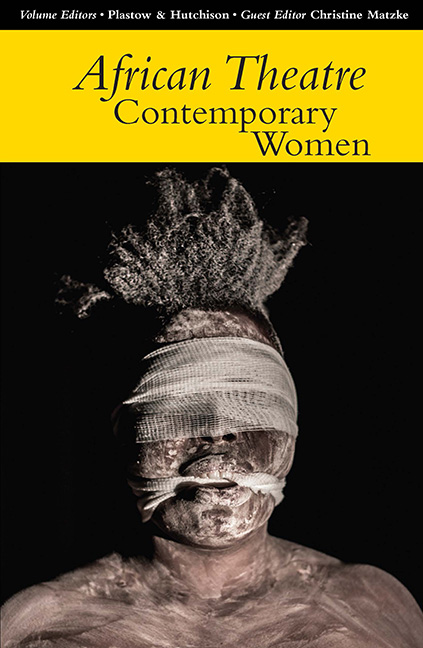Book contents
- Frontmatter
- Contents
- Notes on Contributors
- Editors’ Foreword: Women on the Front Line
- Introduction: Citizen & Artist: African women making theatre
- The Work of Dalia Basiouny: An artist's account
- Performativities as Activism: Addressing gender-based violence & rape culture in South Africa & beyond
- Exploring Poetic Voice in the Uganda Women's Intergenerational Theatre Project
- ‘After Images’: Impressions of the ‘after’ by South African performerchoreographer Mamela Nyamza
- Jalila Baccar of Tunisia: A portrait of an artist
- In Conversation: Interrogating & shifting societal perceptions of women in Botswana through theatre
- Binti Leo: Women in the arts in Tanzania
- Odile Gakire Katese: Making art & reinventing culture with women
- Contemporary Ethiopian Actresses
- Introducing The Sentence
- Playscript
- Book Reviews
Contemporary Ethiopian Actresses
Published online by Cambridge University Press: 05 July 2016
- Frontmatter
- Contents
- Notes on Contributors
- Editors’ Foreword: Women on the Front Line
- Introduction: Citizen & Artist: African women making theatre
- The Work of Dalia Basiouny: An artist's account
- Performativities as Activism: Addressing gender-based violence & rape culture in South Africa & beyond
- Exploring Poetic Voice in the Uganda Women's Intergenerational Theatre Project
- ‘After Images’: Impressions of the ‘after’ by South African performerchoreographer Mamela Nyamza
- Jalila Baccar of Tunisia: A portrait of an artist
- In Conversation: Interrogating & shifting societal perceptions of women in Botswana through theatre
- Binti Leo: Women in the arts in Tanzania
- Odile Gakire Katese: Making art & reinventing culture with women
- Contemporary Ethiopian Actresses
- Introducing The Sentence
- Playscript
- Book Reviews
Summary
Introduction
Ethiopia is an interesting place to look at the changing lives of actresses in Africa, both because it has the longest and strongest tradition of state supported theatre houses anywhere on the continent, and because it has moved from a time when, prior to 1951, all parts were played by men, to a present when leading actresses can be nationally recognized ‘stars’.
The first modern play, written like nearly all Ethiopian theatre in Amharic, dates back to 1921, and was performed by a cast of schoolboys. Play writing subsequently became a fashion among the aristocrats of the court of the last Ethiopian Emperor, Haile Selassie, in the 1930s, and the first professional theatre, the Hager Fikir, was established in the 1940s, followed shortly afterwards by the City Hall Theatre, and in 1955 by the 1,400-seat Haile Selassie 1 Theatre (now the National Theatre with a staff of over 200). Ever since that time theatre-going has been a part of life in the capital Addis Ababa, which currently has five major theatres (though only two were operating fully at the time of writing) with productions also mounted by private companies in a number of halls, and tours regularly undertaken to major cities around the country. At times theatre has played a major political role in agitating for change, and since 1974 the companies in the state theatres have been government employees on recognized salary scales and with full pension rights. A number of attempts to create theatre training schemes have been made since the 1960s, but nowadays most actors, playwrights and directors are graduates of the Theatre Arts Department of Addis Ababa University, which began offering degree courses in 1978.
Ethiopian plays are put on in repertory. A play is normally performed once a week and a run may last for up to three years. Theatre houses put on a number of plays simultaneously, with the largest number being performed at the National Theatre where shows take place every day except Monday, with two performances on Saturdays and Sundays. Ticket prices are regulated, and recently there has been a battle between theatre professionals and the government which wanted to hold prices down to 15 birr (approximately US$ 0.60).
- Type
- Chapter
- Information
- African Theatre 14: Contemporary Women , pp. 97 - 108Publisher: Boydell & BrewerPrint publication year: 2015

